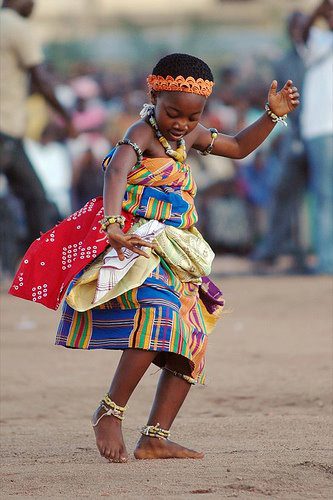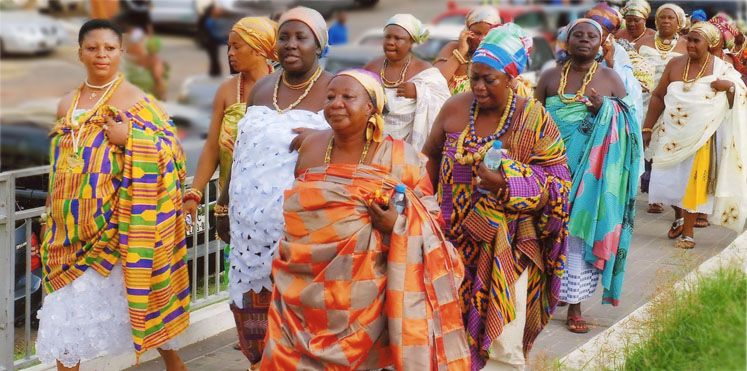Kente cloth holds a place of high significance in Ghanaian and broader West African cultural celebrations. Worn as ceremonial attire, kente transforms regular events into moments of profound cultural expression, symbolizing the values, history, and spirituality of the community. Its vibrant colors and intricate patterns are chosen carefully to reflect the importance of the occasion. Here’s how kente is used in various cultural celebrations:
1. Weddings
Kente is commonly worn at weddings in Ghana and by people of the African diaspora. The cloth symbolizes unity, love, and the sacredness of marriage. Both the bride and groom are often dressed in matching or complementary kente patterns, and each element of their attire carries symbolic meaning related to their union.
Significance: Kente worn at weddings represents the couple’s commitment to one another and honors their cultural heritage. The patterns chosen may reflect values like harmony, partnership, and prosperity in marriage.
Example: The Fathia Fata Nkrumah ("Fathia is a fitting wife for Nkrumah") pattern, which celebrates a strong partnership, is often used in wedding attire to represent the unity between the couple.
2. Funerals
In Ghana, funerals are major social events, and the attire reflects the significance of honoring the deceased. Kente is worn during funeral rites, but the colors and patterns used are typically somber and respectful.
Significance: The color of kente worn at funerals often symbolizes mourning, spiritual reverence, and a connection with ancestors. The patterns might reflect themes of resilience, endurance, and the transience of life.
Example: Kente with black or red colors is often chosen for funerals, as these hues represent mourning and the seriousness of the occasion. Patterns such as Babadua ("Symbol of endurance") might be worn to honor the strength and legacy of the deceased.
3. Festivals and Community Celebrations
Kente is an integral part of festivals, especially those celebrating harvests, historical events, or religious practices. The cloth is worn by chiefs, elders, and festival participants as a symbol of cultural pride and unity. Each kente design and color choice reflects the values celebrated during the festival.
Significance: During festivals like the Akwasidae Festival (a traditional Ashanti celebration honoring ancestors), chiefs and community leaders wear elaborate kente designs that signify power, leadership, and connection to the spiritual world.
Example: The Oyokoman pattern, symbolizing unity and strength, may be worn by community leaders to emphasize the importance of solidarity and leadership within the group.
4. Graduations
Kente has become a global symbol of achievement and pride, particularly in the African diaspora. Graduates often wear kente stoles over their academic robes to celebrate their success and cultural identity.
Significance: Wearing kente at graduations honors not only the individual’s achievement but also the legacy of their ancestors. It represents perseverance, triumph, and a connection to heritage.
Example: Kente stoles in green (symbolizing growth and renewal) or gold (representing prosperity and achievement) are popular among graduates, reflecting their academic success and the promise of future accomplishments.
5. Chieftaincy and Leadership Installations
During the installation of chiefs and leaders, kente cloth is a powerful symbol of authority and legitimacy. Chiefs are dressed in kente to represent their elevated status and responsibility to their people.
Significance: The patterns chosen for these ceremonies often reflect power, wisdom, and leadership. The chief’s kente is often brightly colored and made with luxurious materials to signify wealth and authority.
Example: The Sika Futuro ("Gold dust") pattern is frequently worn by chiefs to convey their wealth, leadership, and connection to the Ashanti royal tradition.
6. Naming Ceremonies
Kente is also worn during outdooring or naming ceremonies, where newborns are introduced to the community. The cloth chosen for the occasion often carries meanings related to new beginnings, blessings, and the hope for the child’s future.
Significance: Parents and family members wear kente patterns that represent the hopes they have for the child’s life. Colors such as white (symbolizing purity and blessings) or blue (for peace and harmony) may be used.
Example: The Afenhyiapa ("Good year") pattern may be worn during naming ceremonies, symbolizing wishes for the child to have a prosperous and successful life.
7. State and Diplomatic Ceremonies
Kente is frequently worn by officials and leaders during important state functions and diplomatic events. It serves as a symbol of Ghana’s cultural heritage and is used to present a unified image of national pride.
Significance: Wearing kente during state events conveys respect for tradition and honors the values of leadership, unity, and patriotism. It is a statement of cultural pride and diplomacy when Ghanaian leaders host or visit foreign dignitaries.
Example: During state functions, patterns such as Asaase Ye Duru ("The earth is heavy"), which symbolizes the significance of the land and the people, may be worn to reflect the importance of the occasion.
8. Religious Ceremonies
In traditional religious and spiritual ceremonies, kente is used to connect with the divine and honor the ancestors. It is often worn during rites of passage, purification rituals, or other sacred events.
Significance: The cloth worn during religious ceremonies often includes patterns and colors that symbolize purity, spirituality, and connection to the spiritual realm. White kente, for example, is frequently worn during purification rituals.
Example: The Nyankonton ("God's eye") pattern is used in religious settings to symbolize divine grace and spiritual protection, reflecting the wearer’s connection to the divine.
Conclusion:
Kente cloth plays a pivotal role in Ghanaian and African diaspora cultural celebrations. Its use in weddings, funerals, festivals, graduations, leadership installations, and other significant events transcends mere aesthetics; it is a deeply symbolic representation of the values, beliefs, and heritage of the people. Each kente pattern tells a story, and its presence at cultural celebrations enriches the meaning of the occasion, connecting individuals to their history, community, and future aspirations.







